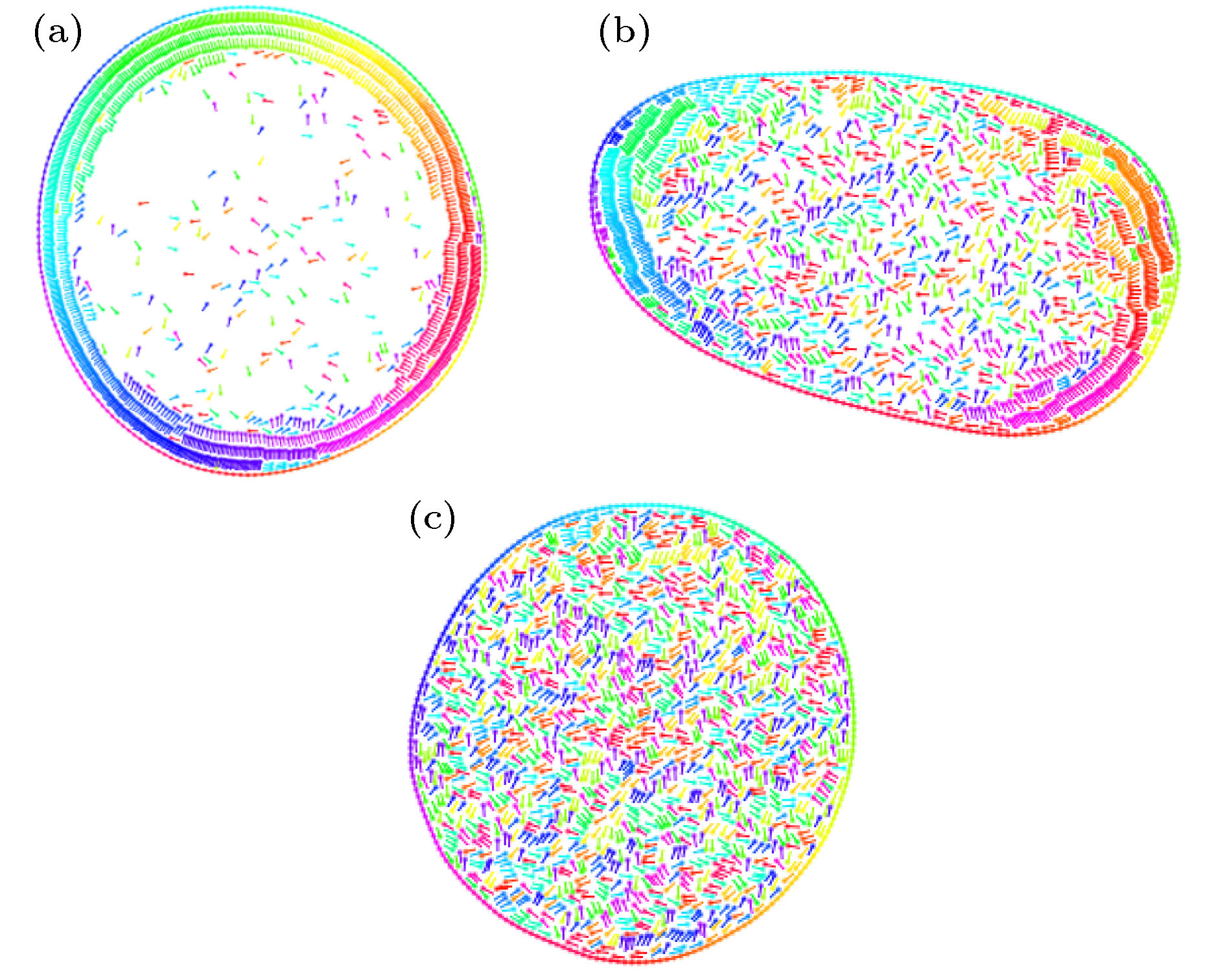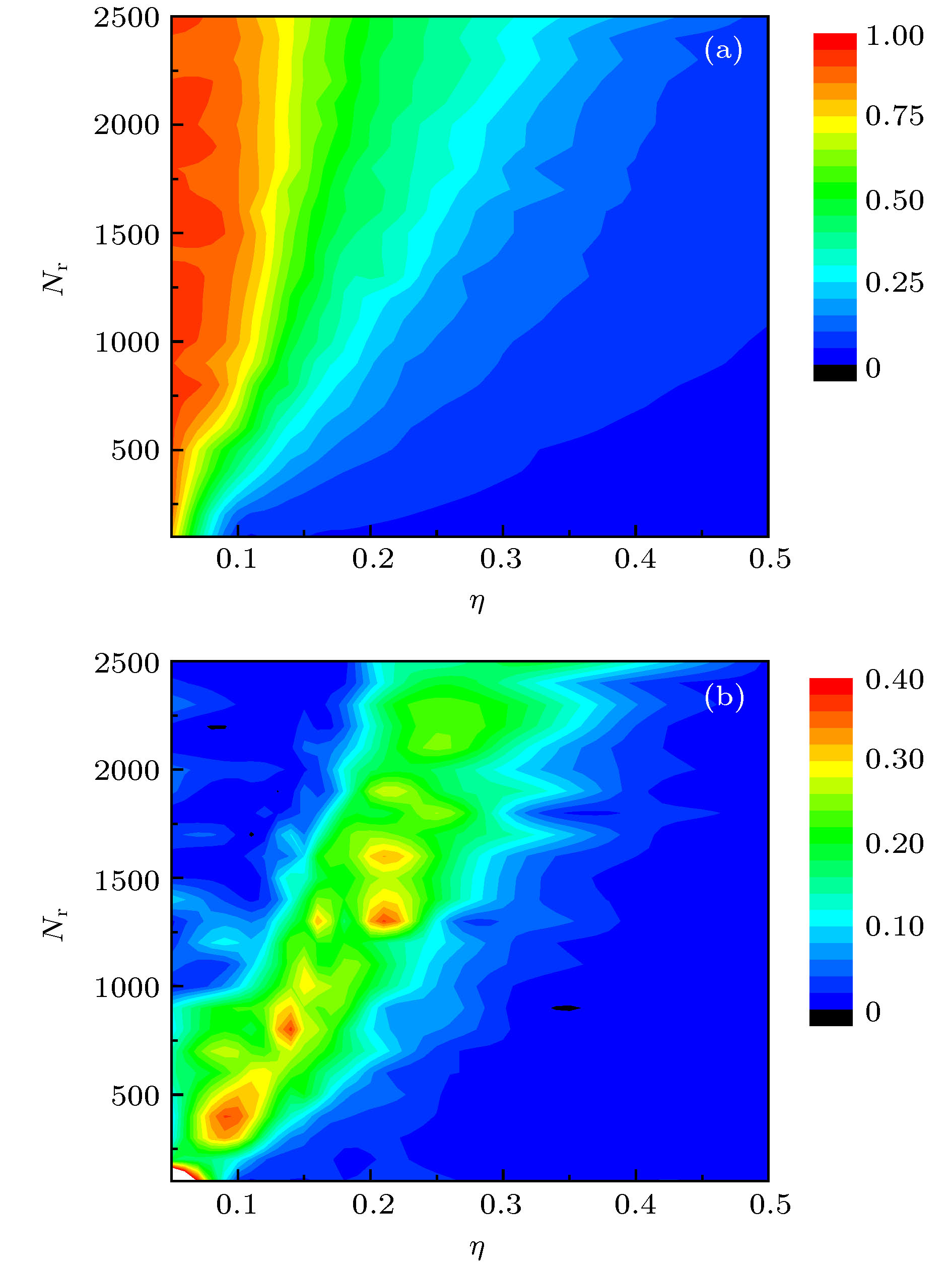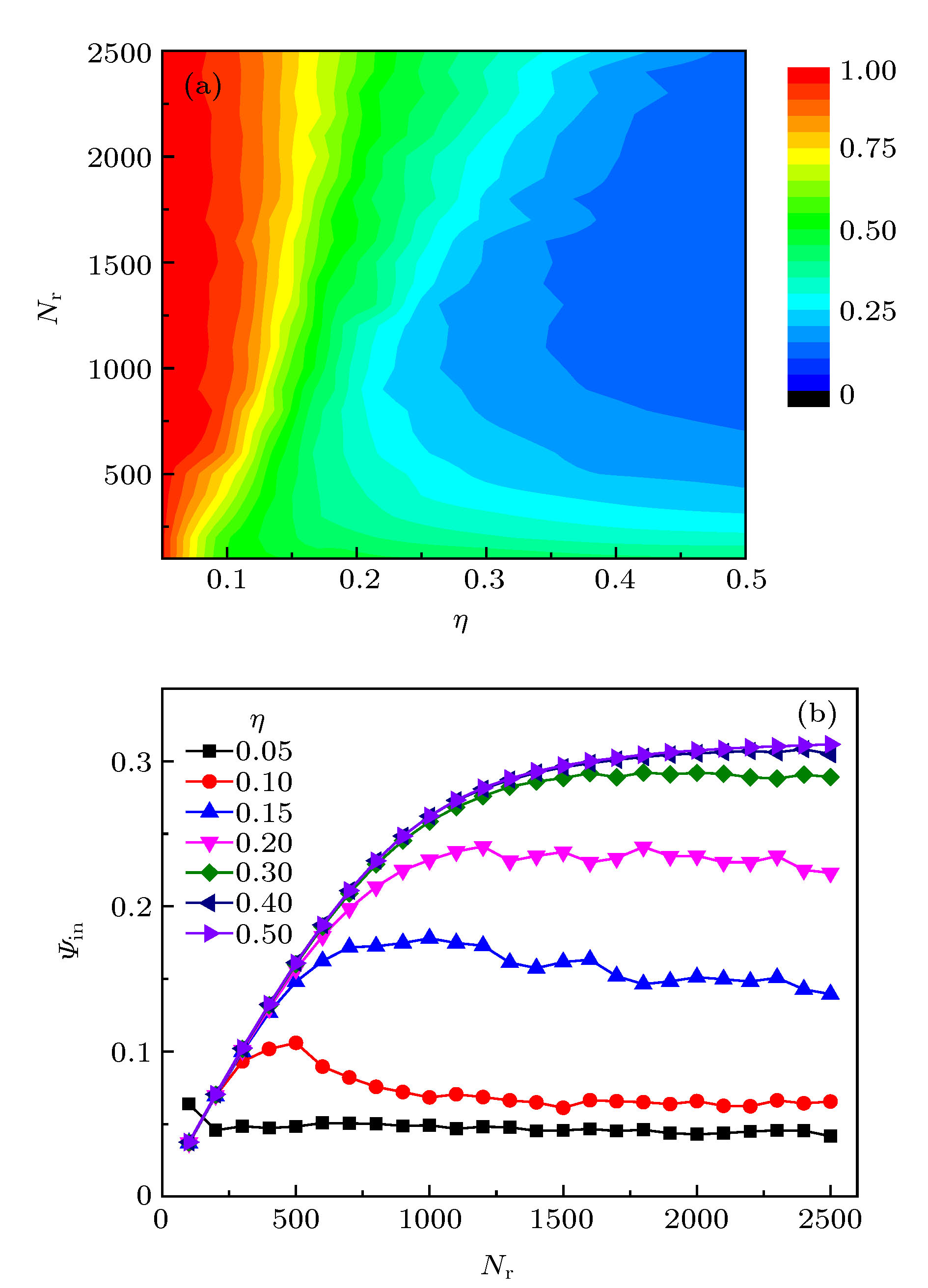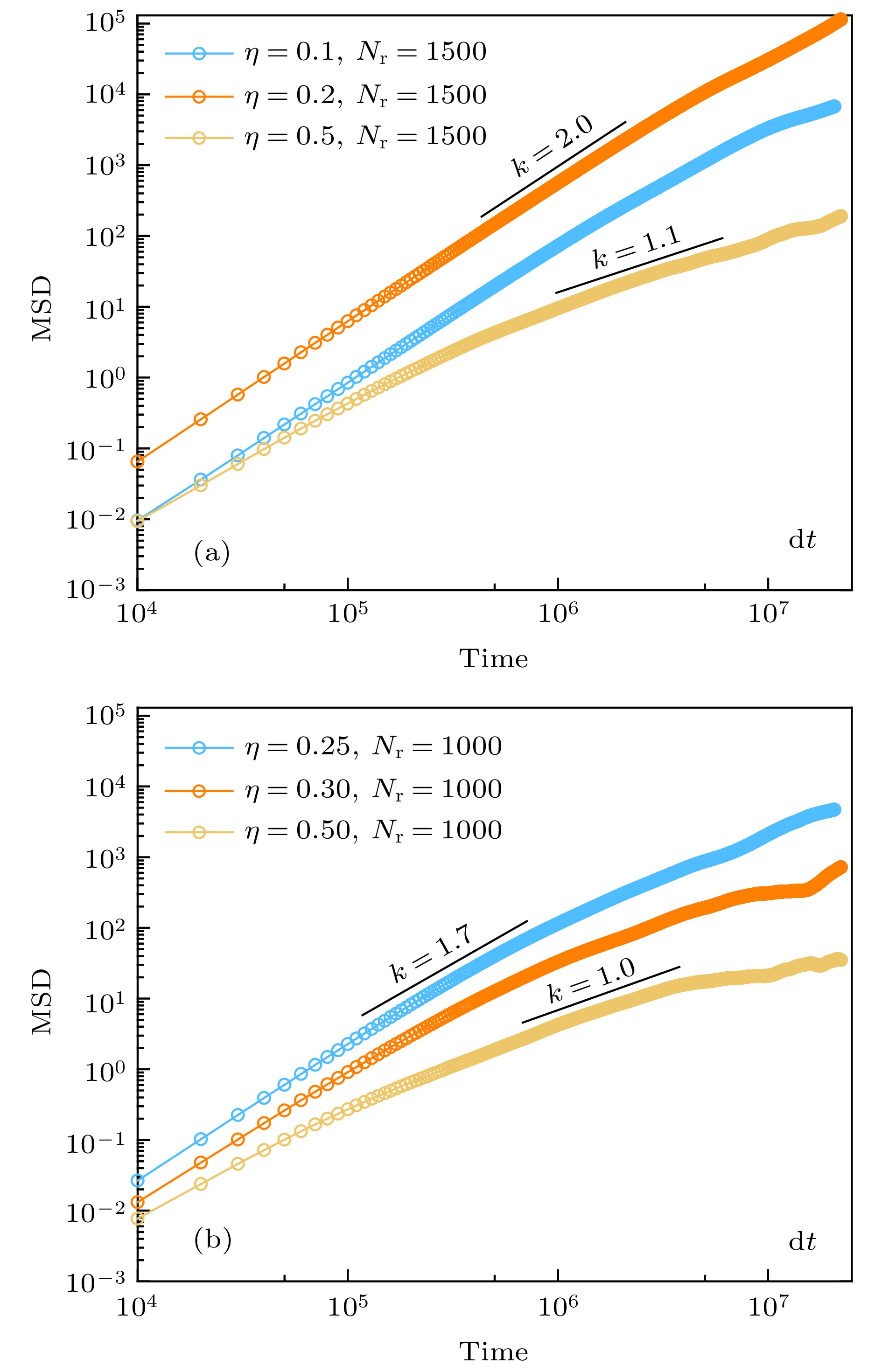-
在生物体系的活性系统中, 杆状粒子在弹性半柔性边界中的受限行为极为常见. 本文研究了二维情况下, 自驱动杆状粒子受限在半柔性弹性环中的集体行为. 改变系统的粒子数及噪声强度, 系统显示明显的自驱吸附有序态、无序态及中间的过渡态. 通过表征弹性环内部粒子的径向极性大小和空间分布的非球度性对这些状态进行了刻画. 进一步对弹性环中心附近粒子密度的分析, 发现环中心气态粒子分布存在一个与边界高密度区域共存的饱和平台, 出现类似吸附转变的粒子分布. 在过渡区间, 体系内存在较大的涨落会导致弹性环出现异常形变. 非对称的粒子分布对弹性环整体的迁移具有重要贡献, 系统在过渡区间能获得相对较强的定向迁移.In biological active systems there commonly exist active rod-like particles under elastic confinement. Here in this work, we study the collective behavior of self-propelled rods confined in an elastic semi-flexible ring. By changing the density of particles and noise level in the system, It is clearly shown that the system has an ordered absorbing phase-separated state of self-propelled rods and the transition to a disordered state as well. The radial polar order parameter and asphericity parameter are characterized to distinguish these states. The results show that the gas density near the central region of the elastic confinement has a saturated gas density that co-exists with the absorbed liquid crystal state at the elastic boundary. In the crossover region, the system suffers an abnormal fluctuation that drives the deformation of the elastic ring. The non-symmetric distribution of particles in the transition region contributes significantly to the collective translocation of the elastic ring.
-
Keywords:
- active matter /
- self-propelled rod /
- absorption phase separation /
- saturation density
[1] Cavagna A, Cimarelli A, Giardina I, Parisi G, Santagati R, Stefanini F, Viale M 2010 Proc. Natl. Acad. Sci. U.S.A. 107 11865
 Google Scholar
Google Scholar
[2] Ballerini M, Cabibbo N, Candelier R, Cavagna A, Cisbani E, Giardina I, Lecomte V, Orlandi A, Parisi G, Procaccini A, Viale M, Zdravkovic V 2008 Proc. Natl. Acad. Sci. U.S.A. 105 1232
 Google Scholar
Google Scholar
[3] Makris N C, Ratilal P, Symonds D T, Jagannathan S, Lee S, Nero R W 2006 Science 311 660
 Google Scholar
Google Scholar
[4] Katz Y, Tunstrom K, Ioannou C C, Huepe C, Couzin I D 2011 Proc. Natl. Acad. Sci. U.S.A. 108 18720
 Google Scholar
Google Scholar
[5] Ginelli F, Peruani F, Pillot M H, Chate H, Theraulaz G, Bon R 2015 Proc. Natl. Acad. Sci. U.S.A. 112 12729
 Google Scholar
Google Scholar
[6] J.-C. Tsai, Fangfu Ye, Juan Rodriguez, J. P. Gollub, Lubensky T C 2005 Phys. Rev. Lett. 94 214301
 Google Scholar
Google Scholar
[7] Zhang H P, Be'er A, Florin E L, Swinney H L 2010 Proc. Natl. Acad. Sci. U.S.A. 107 13626
 Google Scholar
Google Scholar
[8] 陈雷鸣 2016 物理学报 65 186401
 Google Scholar
Google Scholar
Chen L M 2016 Acta Phys. Sin. 65 186401
 Google Scholar
Google Scholar
[9] Fily Y, Marchetti M C 2012 Phys. Rev. Lett. 108 235702
 Google Scholar
Google Scholar
[10] Farrell F D, Marchetti M C, Marenduzzo D, Tailleur J 2012 Phys. Rev. Lett. 108 248101
 Google Scholar
Google Scholar
[11] Weitz S, Deutsch A, Peruani F 2015 Phys. Rev. E 92 012322
[12] Abkenar M, Marx K, Auth T, Gompper G 2013 Phys. Rev. E 88 062314
[13] Surrey T, Nedelec F, Leibler S, Karsenti E 2001 Science 292 1167
 Google Scholar
Google Scholar
[14] Deseigne J, Dauchot O, Chate H 2010 Phys. Rev. Lett. 105 098001
 Google Scholar
Google Scholar
[15] Bialke J, Speck T, Lowen H 2012 Phys. Rev. Lett. 108 168301
 Google Scholar
Google Scholar
[16] Wysocki A, Elgeti J, Gompper G 2015 Phys. Rev. E 91 050302
 Google Scholar
Google Scholar
[17] Costanzo A, Di Leonardo R, Ruocco G, Angelani L 2012 J. Phys. Condens. Matter 24 065101
 Google Scholar
Google Scholar
[18] Isele-Holder R E, Elgeti J, Gompper G 2015 Soft Matter 11 7181
 Google Scholar
Google Scholar
[19] Ginelli F, Peruani F, Bar M, Chate H 2010 Phys. Rev. Lett. 104 184502
 Google Scholar
Google Scholar
[20] Gao T, Blackwell R, Glaser M A, Betterton M D, Shelley M J 2015 Phys. Rev. Lett. 114 048101
 Google Scholar
Google Scholar
[21] Wensink H H, Lowen H 2012 J. Phys. Condens. Matter 24 464130
 Google Scholar
Google Scholar
[22] Ofer N, Mogilner A, Keren K 2011 Proc. Natl. Acad. Sci. U.S.A. 108 20394
 Google Scholar
Google Scholar
[23] Prass M, Jacobson K, Mogilner A, Radmacher M 2006 J. Cell Biol. 174 767
 Google Scholar
Google Scholar
[24] Weichsel J, Schwarz U S 2013 New J. Phys. 15 035006
 Google Scholar
Google Scholar
[25] Theriot J A, Mitchison T J, Tilney L G, Portnoy D A 1992 Nature 357 257
 Google Scholar
Google Scholar
[26] Pantaloni D 2001 Science 292 1502
 Google Scholar
Google Scholar
[27] Lushi E, Wioland H, Goldstein R E 2014 Proc. Natl. Acad. Sci. U.S.A. 111 9733
 Google Scholar
Google Scholar
[28] Wensink H H, Lowen H 2008 Phys. Rev. E 78 031409
 Google Scholar
Google Scholar
[29] Lee C F 2013 New J. Phys. 15 055007
 Google Scholar
Google Scholar
[30] Yang X, Manning M L, Marchetti M C 2014 Soft Matter 10 6477
 Google Scholar
Google Scholar
[31] Abaurrea Velasco C, Dehghani Ghahnaviyeh S, Nejat Pishkenari H, Auth T, Gompper G 2017 Soft Matter 13 5865
 Google Scholar
Google Scholar
[32] Tian W D, Gu Y, Guo Y K, Chen K 2017 Chin. Phys. B 26 100502
 Google Scholar
Google Scholar
[33] Paoluzzi M, Di Leonardo R, Marchetti M C, Angelani L 2016 Sci. Rep. 6 34146
 Google Scholar
Google Scholar
[34] Spellings M, Engel M, Klotsa D, Sabrina S, Drews A M, Nguyen N H, Bishop K J, Glotzer S C 2015 Proc. Natl. Acad. Sci. U.S.A. 112 E4642
 Google Scholar
Google Scholar
[35] Zhang R F, Ren C L, Feng J W, Ma Y Q 2019 Sci. China-Phys. Mech. Astron. 62 117012
 Google Scholar
Google Scholar
[36] Pesek J, Baerts P, Smeets B, Maes C, Ramon H 2016 Soft Matter 12 3360
 Google Scholar
Google Scholar
[37] Lober J, Ziebert F, Aranson I S 2014 Soft Matter 10 1365
 Google Scholar
Google Scholar
[38] Opathalage A, Norton M M, Juniper M P N, et al. 2019 PNAS 116 4788
 Google Scholar
Google Scholar
[39] Keber F C, Loiseau E, Sanchez T, et al. 2014 Science 345 1135
 Google Scholar
Google Scholar
-
图 2 三种典型分布的快照, 自驱动杆粒子数
${N_{\rm{r}}}$ 均为1500, 噪声大小$\eta $ 分别为0.10, 0.20和0.50, 依次对应 (a)自驱吸附有序态、(b)过渡态和(c)无序态. 粒子颜色代表取向, 同图1Fig. 2. The snapshots of three regions with fixed particle number
${N_{\rm{r}}} = 1500$ for different noise levels, and, respectively, with (a)$\eta = 0.10$ , self-propelled particle absorbed ordered region, (b)$\eta = 0.20$ transient region, and (c)$\eta = 0.50$ disordered phase. The color represents the radial direction as Fig.1.图 3 改变噪声强度
$\eta $ 和弹性环中自驱动杆粒子数${N_{\rm{r}}}$ 得到的相图 (a)比较径向极性序参${S_{\rm{p}}}$ 大小得到的热力图; (b)比较非球度$\varDelta $ 大小得到的热力图, 其中转变区域具有极大值Fig. 3. Phase diagrams for self-propelled rods in elastic-ring with varying the noise strength
$\eta $ and the number of self-propelled rods${N_{\rm{r}}}$ , and the order parameter corresponding to (a) the radial polarity${S_{\rm{P}}}$ and (b) the asphericity$\varDelta $ . We have maximal asphericity$\varDelta $ in the transition region.图 4 (a)改变噪声强度
$\eta $ 和自驱动杆粒子数${N_{\rm{r}}}$ , 比较约化密度差P得到的热力图; (b)不同噪声强度$\eta $ 下, 弹性环中心附近粒子数密度随自驱动杆粒子数${N_{\rm{r}}}$ 的变化趋势Fig. 4. (a) Phase diagram of the reduced density difference P for self-propelled rods with varying the noise strength
$\eta $ and the number of self-propelled rods${N_{\rm{r}}}$ ; (b) density of central particles,${\psi _{{\rm{in}}}}$ , versus the particle number${N_{\rm{r}}}$ for different noise strength$\eta $ .图 5 弹性环及杆状粒子质心均方位移随时间的变化 (a)粒子数
${N_{\rm{r}}}$ 为1500时, 噪声大小$\eta $ 为0.10, 0.20和0.50所在三个区区域的比较; (b)粒子数${N_{\rm{r}}}$ = 1000,$\eta $ 为0.25, 0.30和0.50下无序态时的对比Fig. 5. Mean-squared displacement(MSD)for the center of mass of particle and elastic ring: (a) Noise levels
$\eta = 0.10$ ,$\eta = 0.20$ , and$\eta = 0.50$ for${N_{\rm{r}}} = 1500$ ; (b) noise levels for$\eta = 0.25$ ,$\eta = 0.30$ , and$\eta = 0.50$ with particle number${N_{\rm{r}}} = 1000$ in the disordered regime. -
[1] Cavagna A, Cimarelli A, Giardina I, Parisi G, Santagati R, Stefanini F, Viale M 2010 Proc. Natl. Acad. Sci. U.S.A. 107 11865
 Google Scholar
Google Scholar
[2] Ballerini M, Cabibbo N, Candelier R, Cavagna A, Cisbani E, Giardina I, Lecomte V, Orlandi A, Parisi G, Procaccini A, Viale M, Zdravkovic V 2008 Proc. Natl. Acad. Sci. U.S.A. 105 1232
 Google Scholar
Google Scholar
[3] Makris N C, Ratilal P, Symonds D T, Jagannathan S, Lee S, Nero R W 2006 Science 311 660
 Google Scholar
Google Scholar
[4] Katz Y, Tunstrom K, Ioannou C C, Huepe C, Couzin I D 2011 Proc. Natl. Acad. Sci. U.S.A. 108 18720
 Google Scholar
Google Scholar
[5] Ginelli F, Peruani F, Pillot M H, Chate H, Theraulaz G, Bon R 2015 Proc. Natl. Acad. Sci. U.S.A. 112 12729
 Google Scholar
Google Scholar
[6] J.-C. Tsai, Fangfu Ye, Juan Rodriguez, J. P. Gollub, Lubensky T C 2005 Phys. Rev. Lett. 94 214301
 Google Scholar
Google Scholar
[7] Zhang H P, Be'er A, Florin E L, Swinney H L 2010 Proc. Natl. Acad. Sci. U.S.A. 107 13626
 Google Scholar
Google Scholar
[8] 陈雷鸣 2016 物理学报 65 186401
 Google Scholar
Google Scholar
Chen L M 2016 Acta Phys. Sin. 65 186401
 Google Scholar
Google Scholar
[9] Fily Y, Marchetti M C 2012 Phys. Rev. Lett. 108 235702
 Google Scholar
Google Scholar
[10] Farrell F D, Marchetti M C, Marenduzzo D, Tailleur J 2012 Phys. Rev. Lett. 108 248101
 Google Scholar
Google Scholar
[11] Weitz S, Deutsch A, Peruani F 2015 Phys. Rev. E 92 012322
[12] Abkenar M, Marx K, Auth T, Gompper G 2013 Phys. Rev. E 88 062314
[13] Surrey T, Nedelec F, Leibler S, Karsenti E 2001 Science 292 1167
 Google Scholar
Google Scholar
[14] Deseigne J, Dauchot O, Chate H 2010 Phys. Rev. Lett. 105 098001
 Google Scholar
Google Scholar
[15] Bialke J, Speck T, Lowen H 2012 Phys. Rev. Lett. 108 168301
 Google Scholar
Google Scholar
[16] Wysocki A, Elgeti J, Gompper G 2015 Phys. Rev. E 91 050302
 Google Scholar
Google Scholar
[17] Costanzo A, Di Leonardo R, Ruocco G, Angelani L 2012 J. Phys. Condens. Matter 24 065101
 Google Scholar
Google Scholar
[18] Isele-Holder R E, Elgeti J, Gompper G 2015 Soft Matter 11 7181
 Google Scholar
Google Scholar
[19] Ginelli F, Peruani F, Bar M, Chate H 2010 Phys. Rev. Lett. 104 184502
 Google Scholar
Google Scholar
[20] Gao T, Blackwell R, Glaser M A, Betterton M D, Shelley M J 2015 Phys. Rev. Lett. 114 048101
 Google Scholar
Google Scholar
[21] Wensink H H, Lowen H 2012 J. Phys. Condens. Matter 24 464130
 Google Scholar
Google Scholar
[22] Ofer N, Mogilner A, Keren K 2011 Proc. Natl. Acad. Sci. U.S.A. 108 20394
 Google Scholar
Google Scholar
[23] Prass M, Jacobson K, Mogilner A, Radmacher M 2006 J. Cell Biol. 174 767
 Google Scholar
Google Scholar
[24] Weichsel J, Schwarz U S 2013 New J. Phys. 15 035006
 Google Scholar
Google Scholar
[25] Theriot J A, Mitchison T J, Tilney L G, Portnoy D A 1992 Nature 357 257
 Google Scholar
Google Scholar
[26] Pantaloni D 2001 Science 292 1502
 Google Scholar
Google Scholar
[27] Lushi E, Wioland H, Goldstein R E 2014 Proc. Natl. Acad. Sci. U.S.A. 111 9733
 Google Scholar
Google Scholar
[28] Wensink H H, Lowen H 2008 Phys. Rev. E 78 031409
 Google Scholar
Google Scholar
[29] Lee C F 2013 New J. Phys. 15 055007
 Google Scholar
Google Scholar
[30] Yang X, Manning M L, Marchetti M C 2014 Soft Matter 10 6477
 Google Scholar
Google Scholar
[31] Abaurrea Velasco C, Dehghani Ghahnaviyeh S, Nejat Pishkenari H, Auth T, Gompper G 2017 Soft Matter 13 5865
 Google Scholar
Google Scholar
[32] Tian W D, Gu Y, Guo Y K, Chen K 2017 Chin. Phys. B 26 100502
 Google Scholar
Google Scholar
[33] Paoluzzi M, Di Leonardo R, Marchetti M C, Angelani L 2016 Sci. Rep. 6 34146
 Google Scholar
Google Scholar
[34] Spellings M, Engel M, Klotsa D, Sabrina S, Drews A M, Nguyen N H, Bishop K J, Glotzer S C 2015 Proc. Natl. Acad. Sci. U.S.A. 112 E4642
 Google Scholar
Google Scholar
[35] Zhang R F, Ren C L, Feng J W, Ma Y Q 2019 Sci. China-Phys. Mech. Astron. 62 117012
 Google Scholar
Google Scholar
[36] Pesek J, Baerts P, Smeets B, Maes C, Ramon H 2016 Soft Matter 12 3360
 Google Scholar
Google Scholar
[37] Lober J, Ziebert F, Aranson I S 2014 Soft Matter 10 1365
 Google Scholar
Google Scholar
[38] Opathalage A, Norton M M, Juniper M P N, et al. 2019 PNAS 116 4788
 Google Scholar
Google Scholar
[39] Keber F C, Loiseau E, Sanchez T, et al. 2014 Science 345 1135
 Google Scholar
Google Scholar
计量
- 文章访问数: 14179
- PDF下载量: 203
- 被引次数: 0














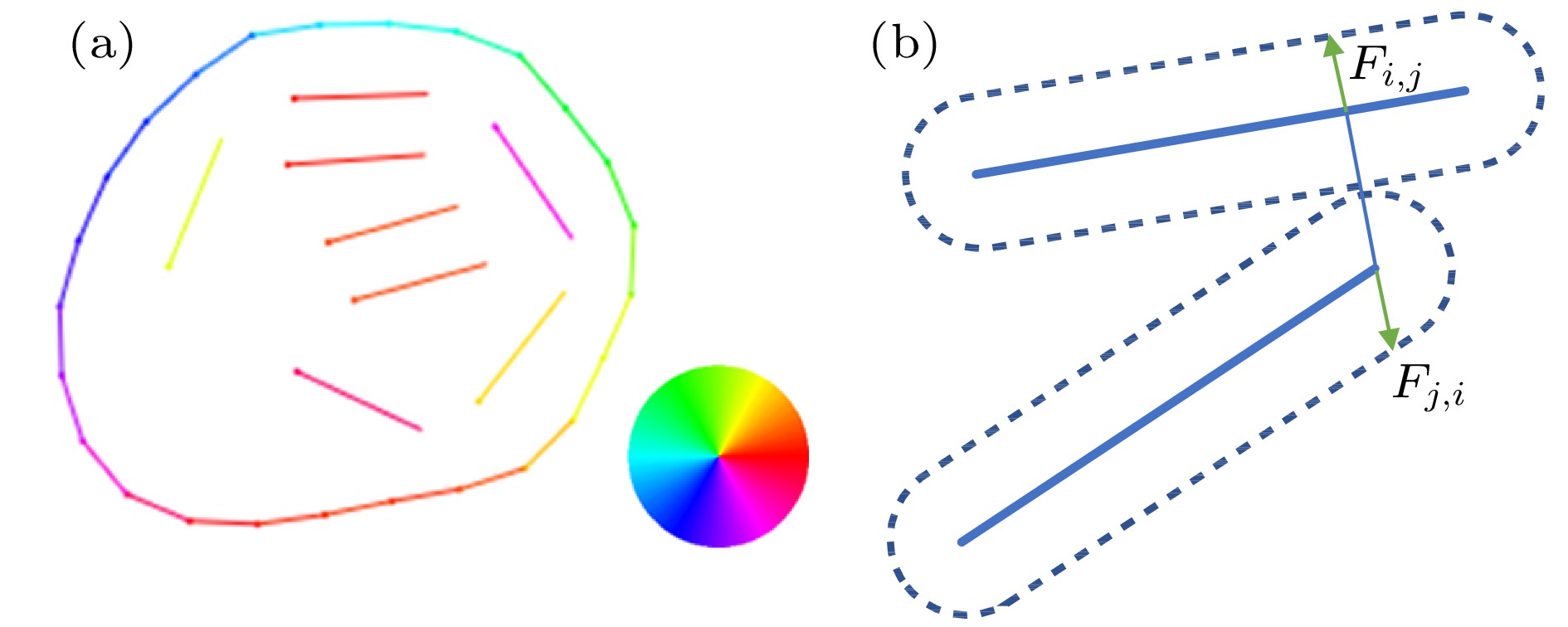
 下载:
下载:
